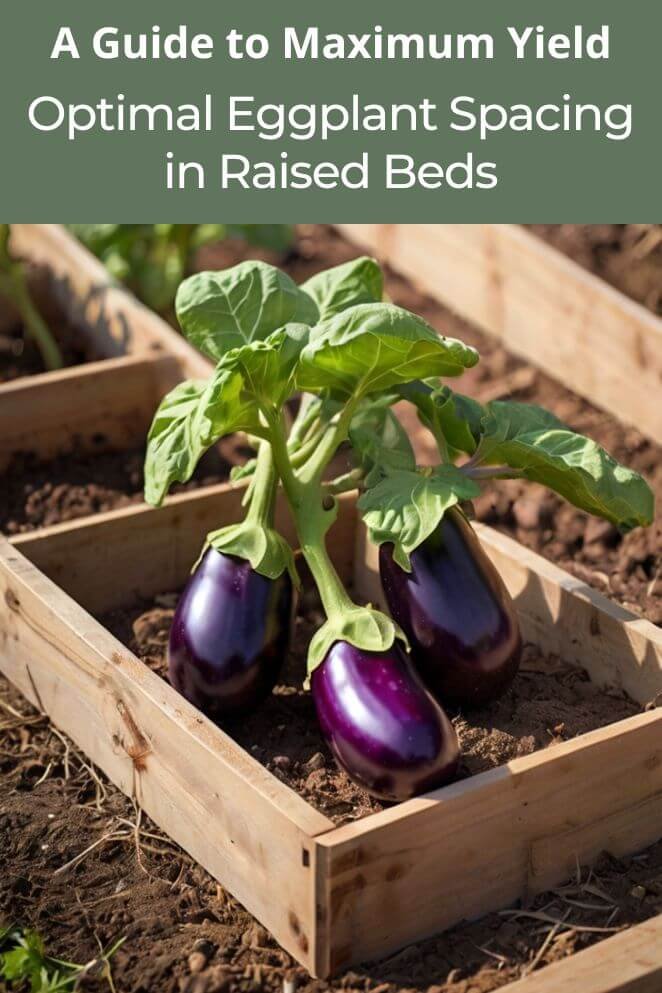
Growing eggplants in raised beds can be a highly productive and rewarding gardening practice.
However, one of the most important factors that often gets overlooked is proper spacing.
This simple yet crucial step can make the difference between a bountiful harvest and a lackluster one.
In this post, we will dive deep into the importance of eggplant spacing, how to determine the right distance for different varieties, and how to optimize your raised bed garden to maximize your eggplant yield.
Benefits of Proper Eggplant Spacing
Better airflow and sunlight
When you space your eggplants correctly, they get the right amount of air circulation and sunlight.
Good airflow helps reduce moisture on the leaves, which can prevent fungal diseases.
Sunlight is essential for photosynthesis, which keeps your plants healthy and growing strong.
- Read also: Beat the Blight: Identifying Fungal Diseases of Eggplant
- Read also: Identifying and Combating Bacterial Wilt in Eggplant Plants
Less competition for resources
If your eggplants are planted too close together, they’ll fight over water, nutrients, and light.
This can stunt their growth, resulting in smaller plants and fewer fruits.
By giving each plant enough space, you ensure they have all the resources they need to thrive.
Easier pest and disease management
When plants are overcrowded, it creates the perfect environment for pests and diseases.
Poor airflow and excess moisture make it harder to spot issues like aphids or fungal infections.
Proper spacing makes it easier to notice and address problems before they spread.
Bigger harvests and better quality
Well-spaced eggplants grow stronger and produce larger, tastier fruits.
When plants aren’t crowded, they have the room to reach their full potential, leading to a higher yield with better-quality eggplants.

Factors Affecting Eggplant Spacing
Eggplant variety: Size and growth habit
Different types of eggplants grow to different sizes.
Smaller varieties like Chinese or Thai eggplants don’t need as much space compared to larger ones like Black Beauty or Graffiti eggplants.
Knowing the size and growth pattern of your variety will help you choose the right spacing for healthy growth.
Size of your raised bed
The size of your raised bed will determine how many eggplants you can fit.
If you have a small or narrow bed, you might be limited in how many plants you can grow.
Larger beds give you more flexibility, allowing for better spacing and more plants.
Climate and length of growing season
In warm climates with long growing seasons, eggplants tend to grow bigger and may need more room.
In cooler climates with shorter seasons, the plants usually stay smaller, so you can plant them closer together.
How much you want to harvest
If you’re aiming for a big harvest of smaller fruits, planting your eggplants closer together might work.
However, if you want fewer but larger fruits, you’ll need to give each plant more space to spread out and grow fully.
Spacing Recommendations for Different Raised Bed Sizes
Small raised beds
Dimensions: Less than 4 feet wide
Spacing suggestion
In small raised beds, space is limited, so you’ll need to be strategic about how many eggplants you plant.
Ideally, you should limit the number of plants to 2 or 3.
Spacing them about 18 inches apart in a staggered or grid pattern will give them enough room to grow without overcrowding.
This arrangement helps ensure that each plant gets enough light, air, and nutrients.
Medium raised beds
Dimensions: 4 to 6 feet wide
Spacing suggestion
With a medium-sized bed, you have more options.
For medium-sized eggplant varieties, you can space the plants about 18 to 24 inches apart, depending on how large they grow.
Larger varieties should be spaced 24 inches apart.
You can arrange the plants in rows or grids, giving each one enough space to grow strong and healthy.
This setup is great for balancing a good number of plants with proper spacing.
Large raised beds
Dimensions: More than 6 feet wide
Spacing suggestion
In larger raised beds, you have plenty of space to work with.
You can plant multiple rows of eggplants, ensuring that each plant has plenty of room to spread out.
For larger eggplant varieties, spacing them about 30 inches apart will allow them to grow to their full potential.
This wider spacing helps prevent crowding, which ensures better air circulation and reduces the risk of diseases.

Tips for Efficient Eggplant Spacing
Using a garden grid or marker to ensure even spacing
When planting eggplants, even spacing is important to give each plant the best chance to thrive.
A helpful tool to achieve this is a garden grid or marker.
You can create a simple grid using stakes and string or buy pre-made ones designed for gardening.
This system helps you visualize exactly where to plant, ensuring each eggplant gets enough room to grow.
A neat and organized layout not only looks good but also helps your plants stay healthy by avoiding overcrowding.
Planting in rows or a staggered pattern
Another way to make efficient use of space is by planting your eggplants in rows or a staggered (zig-zag) pattern.
If you plant them in straight rows, it’s easier to water and manage your garden, but a staggered pattern can be more space efficient.
Staggered planting gives each plant more access to sunlight and improves airflow between them, which can help reduce the spread of diseases.
This method also makes it easier to spot pests or issues that may develop, helping your eggplants stay healthy.
Considering the growth habit of the eggplant variety
Not all eggplants grow the same way. Some varieties grow tall and upright, while others spread out more horizontally.
Knowing the growth habits of your eggplant variety is essential for proper spacing.
For example, a tall-growing variety might only need a small footprint of space on the ground but will require more vertical room.
Meanwhile, bushier types will need more horizontal space to spread their branches.
By understanding how your chosen variety grows, you can ensure they have the right amount of room to grow without competing with each other for light or nutrients.

- Read also: Planting Perfection: The Ultimate Guide to Spacing for Cucumbers
- Read also: Tiny Garden, Big Harvest: DIY Vegetable Garden For Small Spaces
Final Thoughts
Proper eggplant spacing in raised beds is critical to the success of your garden.
By ensuring each plant has enough room to grow, you can boost airflow, reduce competition for resources, and prevent diseases.
Whether you’re growing small, medium, or large varieties, paying attention to the spacing needs of your plants will lead to a healthier garden and a more abundant harvest.



